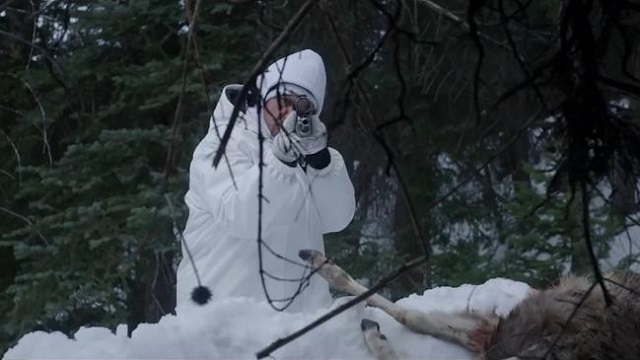The biggest question of this decade seems to be “How do you make an advocacy narrative that won’t scare away people not in the choir?” Roland Emmerich wanted to make a movie about Stonewall that spoke to middle America about the plague of homeless gay youth; so he created a fictional middle American white gay boy to cry during blow jobs and throw the first brick. Kathryn Bigelow wanted to make a movie about black riots that spoke to middle American about the oppression of black people; so she made Detroit, a movie without a central character so as to not specify the oppression and prevent people from saying “this is an exception to the rule.” Taylor Sheridan wanted to make a movie about the systemic oppression of First Nations people that spoke to a wide non-Native audience; so, he made a movie that centralized a white male savior in a story about a raped and murdered First Nation woman.
Wind River opens with Natalie Hanson (Kelsey Chow) running barefoot in sub-zero weather before dying; her not-so-secret is that she was raped. In two hours of movie, Taylor Sheridan never allows any of the living characters to probe into Natalie Hanson’s life beyond her having a white boyfriend who worked at a drilling facility. Natalie is not a mystery. She is a dead raped Native American girl who was once best friends with another Native American girl who was found dead three years ago, and that sums up her total presence in Wind River.
Instead of being about Natalie Hanson or even any of the people she touched, Wind River is about Twin Peaks‘s Hawk…er…Cory Lambert (Jeremy Renner), a white guy whose main connection to the First Nations is that he works their land as a hunter and was married to a Native American woman who mothered two of his children. Cory is hunting a family of mountain lions when he stumbles on Natalie’s frozen dead body in the middle of nowhere. His main connection to Natalie is that his daughter was Natalie’s best friend before her own death three years prior.
At first, Cory is helped by Twin Peaks‘ Sheriff Truman…er…Tribal Officer Ben (Graham Greene), a character so important that neither IMDb nor Wikipedia list his last name. Due to the extreme nature of the case, they call in the FBI and get audience surrogate Dale Cooper…er…Clarice Starling…er…Jane Banner (Elizabeth Olsen) an FBI agent-in-training so incompetent she arrives in the midst of a blizzard wearing little more than a windbreaker.
Neither of these characters matter much to the narrative. Officer Ben is here to show that some tribal elders have a sense of morality while Clarice Cooper is here to look incompetent and be repeatedly saved by Cory Lambert’s slick hunting techniques. Despite Wind River being ostensibly about Native American oppression, we learn the most about Cory Lambert. Through his various stories, we learn his love life, his work history, his lineage, and even the story of his dead daughter. No First Nations character gets this privilege, mainly hanging around the background to do drugs and be angry, violent, sad and resentful.
Most obviously, Taylor Sheridan wanted to make a 2 hour version of Twin Peaks, but found himself way too fascinated with the investigation than with the characters and denied Natalie the dignity given to Laura Palmer. He wanted to make a movie about Native American oppression, but focused on a White Savior character who repeatedly states that he is hunting down the rapist.
All of this would be easily dismissed as ignorant storytelling. But, then came the final title cards. Any fan of bad advocacy movies knows that they always come with bad final “factoids.” Stonewall told the stories of all the real life advocates that it shoved to the side in the main narrative. The Imitation Game remains the champion of bad title cards with the condescending “Today, we call them computers.” Wind River gives them all a run for their money. At the end of this story, the title cards inform us that nobody collects statistics about missing Native American women and that nobody knows how many are actually missing.
Now, stop…
There is no Native American woman in Wind River who goes missing. Natalie is a dead body found in the first act. Emily, Cory’s dead daughter, went missing but was found 60 miles away and eaten by coyotes. There is only one person to “go missing” in Wind River, and they are neither a Native American nor a woman. Listen, movie, if you’re going to give us advocacy factoids, CAN YOU PLEASE MAKE A NARRATIVE THAT HAS A CONNECTION TO THOSE FACTOIDS?!!? WHY THE FUCK DID YOU TELL US THIS?!
Besides the terrible storytelling, Taylor Sheridan is a shitty director. Wind River suffers from incompetent editing (I swear, some people are shot 5 separate times), an overdependence on shakycam for added “realism” and a lazy score with that Fargo violin. Wind River is the cinematic equivalent of Dan Brown trying to write a novelization of Twin Peaks: it’s slow, plodding, poorly told, and is inexplicably popular. This is one of the strongest contenders for worst movie of the year.

